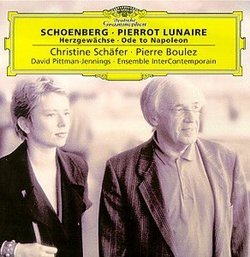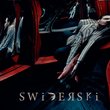| All Artists: Arnold Schoenberg, Pierre Boulez, Christine Schäfer, David Pittman-Jennings, Ensemble InterContempolain, Florent Boffard, Jeannne Marie Conquer, Christophe Desjardins, Hae Sun Kang, Sophie Cherrier, Alain Damiens Title: Schoenberg - Pierrot lunaire ~ Herzgewächse ~ Ode to Napoleon / Schäfer, Pittman-Jennings, Ensemble InterContempolain, Boulez Members Wishing: 1 Total Copies: 0 Label: Deutsche Grammophon Release Date: 10/20/1998 Genres: Special Interest, Pop, Classical Styles: Vocal Pop, Opera & Classical Vocal, Historical Periods, Modern, 20th, & 21st Century Number of Discs: 1 SwapaCD Credits: 1 UPCs: 028945763026, 028945763026 |
Search - Arnold Schoenberg, Pierre Boulez, Christine Schäfer :: Schoenberg - Pierrot lunaire ~ Herzgewächse ~ Ode to Napoleon / Schäfer, Pittman-Jennings, Ensemble InterContempolain, Boulez
 | Arnold Schoenberg, Pierre Boulez, Christine Schäfer Schoenberg - Pierrot lunaire ~ Herzgewächse ~ Ode to Napoleon / Schäfer, Pittman-Jennings, Ensemble InterContempolain, Boulez Genres: Special Interest, Pop, Classical
No Description Available No Track Information Available Media Type: CD Artist: SCHOENBERG,A. Title: PIERROT LUNAIRE/HERZGEWACHSE Street Release Date: 10/20/1998 |
Larger Image |
CD DetailsSynopsis
Product Description No Description Available No Track Information Available Media Type: CD Artist: SCHOENBERG,A. Title: PIERROT LUNAIRE/HERZGEWACHSE Street Release Date: 10/20/1998 Similar CDs
|
CD ReviewsOne of the Best Schoenberg Discs Available... Sébastien Melmoth | Hôtel d'Alsace, PARIS | 01/30/2005 (5 out of 5 stars) "This is a superb disc in many ways: it features three of Schoenberg's great pieces, one of which (Herzgewächse) is virtually unavailable anywhere else. Since the death of von Karajan, Boulez is now the greatest conductor in the world now working; and his understanding of Second Viennese School oeuvre is as insightful as Karajan's was. Christine Schäfer--for my money and to my ear--is the greatest soprano now working: her voice is exquisite: not shrill nor brittle, but rich, moist, and pure, and oh-so-effortless: she's absolutely wonderful, and she, too, has a deep insight into Modern music: for example, she sings the part of Lulu in Berg's eponymous opera. As for the works: Herzgewächse is an exquisite song of about 4 min duration. It contains a hair-raising Expressionistic leap of the voice at climax, which Webern called, "the summit of music." The text is by Symbolist Belgian Maeterlinck. Byron's Ode to Napoleon is about 20 mins of excoriating sarcasm and bitter irony on the capitulation of the Corsican. Schoenberg, to whom the sentiments of sarcasm and irony came naturally--set Byron's Ode in English as a protest against Hitler, Stalin, totalitarianism, and autocracy. Set for piano quintet, it's too, too wonderful. It's a 12-tone work, but the tones chosen have tonal ambiguities which also hint at Beethoven's Eroica. Pierrot Lunaire is of course Schoenberg's most infamous piece. Here it is made most approachable by Boulez and Schafer. The problematic "speech-song" which Schoenberg calls for is smoothed-out by Schafer. Outstanding performances of exquisite works, well recorded." When the mmon announces apocalyptic history Jacques COULARDEAU | OLLIERGUES France | 03/05/2009 (5 out of 5 stars) "The first striking element is that the text is long and not at all sung: a rich poetic text dramatically spoken along several totally innovative lines. Three dimensions of the language are used to create vocal music. First the rhythm created with syllables, making them long or short. This is a basic musical element of the language and many poets have used it, even in languages that do not have such a characteristic, very often it is true in songs but also in the stage directions of a play. But such a trait was essential in Shakespeare and was basic in Purcell and Handel. The second element is intonation: Schoenberg uses something that is going to become extremely common later on with the radio. He widely uses high dives and high jumps and all variations in between to create another type of music that is amplified by the first element making the tips of the intonation lines long and thus multiplying the effect. The third element is the force and intensity of each syllable from very weak to very powerful, and this trait is a very common dramatic way to emphasize one's discourse in everyday life. Even without listening to the words we are able to hear that music that is extremely expressive. The instrumental music is then nothing but an accompaniment that also plays on the same outer aspect. It is not a melodious line, certainly not the music of a song since the text is not sung. It is a real accompaniment as it existed for example in the Middle Ages, in the Gregorian and even late Gregorian traditions and polyphonies, with variations in the balance between text and music. At times the music takes over, at other times the text is dominant. The music does not really create an atmosphere but sustains, supports and increases the atmosphere created by the voice, the diction, though a longer musical sequence can occur, for instance at the end of the 13th piece, "Enthauptung" as if the text was the beheading itself: the text is cut off from the music at the end and the music alone remains like a head or a body severed from its host. This is new though we cannot know how things were done before the recording technology made it possible to keep a trace of evanescent artistic interpretation. But it is possible to find spoken elements in operas and oratorios of previous periods, at least in the score. Prosody was a tradition in our music, a tradition that goes back to King David's codification and his music school in the Temple. Prosody as opposed to psalmody, two forms of poetry in the Bible and two forms of musical rendition of these two types of poetry (that was to become ternary with Bach's Passions: the Evangelist's prosody, the hymnal psalmody and the arias' virtuoso psalmody. But one can hear another poetical music. It is the regularity of the stanzas. Each piece is composed of three stanzas, two four-lined stanzas and one five-lined stanza. These stanzas are supported by no rhyming of any sort though, at the most some assonances and an obvious play on German feminine and masculine endings. But the pieces are built on a complex musical pattern. The first two lines of the first stanza are repeated at the end of the second stanza and the first line of the first stanza at the end of the third stanza, thus embracing the whole poem. This music of a double fading out echo creates a resonance in the text that also gives some depth to the text itself. The length of the lines is very regular, though the 12th piece "Galgenlied" has very short lines (five syllables instead of eight or nine). Moreover the whole work is divided in three parts, each composed of seven pieces. Some other numerical elements are signifying in this poem. Each piece has 13 lines. The 21 (3 x 7) pieces count 63 stanzas (6 + 3 = 9) and the complete number of lines is 819 (8 + 1 + 9 = 9 + 9 = 18 = 6 + 6 + 6). The beast of John's Book of Revelation is ever present: 666 (Revelation, 13) and three times 9 (idem, Jerusalem Bible's notes on 666). The night is dominant and the main luminary is the moon which is associated to blood and red, and to the dead and death. The negative linguistic elements are overpowering, particles for verbs, negative for nouns and words with negative meanings (blind, mute). This extremely negative vision of the night, the moon and Pierrot, the embodiment of both, is in perfect continuity with the Oscar Wilde's vision in "Salome" and Franck Wedekind's in the Lulu plays. Oscar Wilde's "Salome" was adapted to the operatic stage in 1915 by Richard Strauss. We can note that Wedekind's Lulu plays will be adapted to the operatic stage by Alban Berg in the 1930s. We could also think of the morbid vision of the moon Apollinaire develops in the same period. This artistic vision can also be found in Picasso's clowns and circus people in his blue period just before his cubist revolution. These artists are producing new forms of art due to the great technical inventions, but also they are conscious of a drama that is going to come soon, starting in 1914 and ending in 1945. The means used are images and semantic references, new forms of music and poetry, numerical rhythms and tempos, both prosody and psalmody, and vast cultural, even anthropologically meaningful references. The moon though seems to be very pregnant in that crucial period when the industrial revolution is shifting from mechanical forms to electrical forms, from machines to knowledge.
Dr Jacques COULARDEAU, University Paris 1 Pantheon Sorbonne, University Versailles Saint Quentin en Yvelines, CEGID." |

 Track Listings (23) - Disc #1
Track Listings (23) - Disc #1